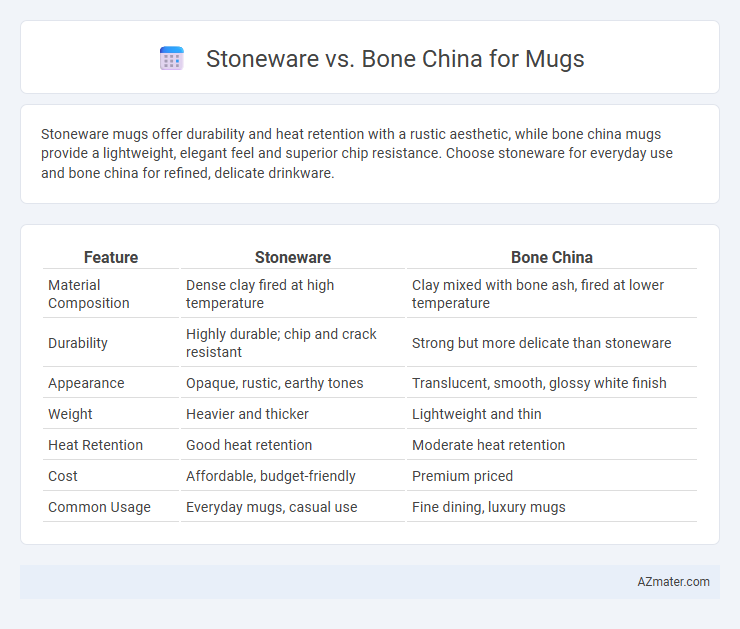Stoneware mugs offer durability and heat retention with a rustic aesthetic, while bone china mugs provide a lightweight, elegant feel and superior chip resistance. Choose stoneware for everyday use and bone china for refined, delicate drinkware.
Table of Comparison
| Feature | Stoneware | Bone China |
|---|---|---|
| Material Composition | Dense clay fired at high temperature | Clay mixed with bone ash, fired at lower temperature |
| Durability | Highly durable; chip and crack resistant | Strong but more delicate than stoneware |
| Appearance | Opaque, rustic, earthy tones | Translucent, smooth, glossy white finish |
| Weight | Heavier and thicker | Lightweight and thin |
| Heat Retention | Good heat retention | Moderate heat retention |
| Cost | Affordable, budget-friendly | Premium priced |
| Common Usage | Everyday mugs, casual use | Fine dining, luxury mugs |
Introduction to Stoneware and Bone China
Stoneware mugs are crafted from dense, durable clay fired at high temperatures, making them highly resistant to chipping and ideal for everyday use. Bone china mugs, composed of fine bone ash, kaolin, and feldspar, are lightweight with a translucent quality and renowned for their delicate, elegant appearance. Both materials offer unique advantages: stoneware excels in sturdiness and rustic charm, while bone china provides refined aesthetics and a smooth, glossy finish.
Material Composition and Origins
Stoneware mugs are crafted from dense clay fired at high temperatures, resulting in durable, non-porous ceramics with a rustic, earthy aesthetic originating from ancient pottery traditions. Bone china mugs incorporate bone ash, feldspar, and kaolin, creating a lightweight, translucent, and highly refined porcelain first developed in 18th-century England. Material composition influences durability and appearance, with stoneware being heavier and more robust, while bone china offers delicate elegance and superior chip resistance.
Durability and Strength Comparison
Stoneware mugs offer exceptional durability due to their dense, non-porous composition, making them highly resistant to chips and cracks from everyday use. Bone china mugs, while renowned for their delicate appearance and lightweight feel, provide considerable strength thanks to the inclusion of bone ash, which enhances translucency and resilience. When comparing durability, stoneware generally withstands rough handling better, whereas bone china excels in strength relative to its thinness but requires more careful handling to avoid damage.
Weight and Thickness Differences
Stoneware mugs are typically heavier and thicker than bone china mugs, providing a robust feel and better heat retention. Bone china, made from a blend of bone ash and porcelain, is lighter and thinner, offering a delicate, refined appearance while remaining strong despite its reduced weight. The density difference influences durability and thermal properties, making stoneware ideal for casual use and bone china preferred for elegant settings.
Heat Retention and Insulation
Stoneware mugs excel in heat retention due to their thick, dense material, which keeps beverages warmer for longer periods compared to bone china. Bone china, while lightweight and elegant, offers less insulation as its thinner walls cool drinks more quickly. For those prioritizing heat retention and insulation, stoneware provides superior thermal performance in everyday mug use.
Aesthetic Appeal and Design Options
Stoneware mugs offer a rustic, earthy aesthetic characterized by textured surfaces and natural matte finishes, appealing to those who favor artisanal and organic designs. Bone china mugs exhibit a refined elegance with translucent qualities and smooth, glossy surfaces that complement intricate patterns and delicate color schemes. Design options for stoneware emphasize hand-crafted uniqueness and robustness, while bone china provides sophisticated shapes and detailed artwork suited for formal settings.
Everyday Use and Suitability
Stoneware mugs offer exceptional durability and heat retention, making them ideal for everyday use and resistant to chips and cracks from frequent handling. Bone china mugs provide a lightweight, elegant option with superior whiteness and translucency but require more delicate care to prevent damage during daily use. Choosing between stoneware and bone china depends on balancing durability needs with aesthetic preferences for regular mug use.
Cleaning and Maintenance Requirements
Stoneware mugs require minimal maintenance and are dishwasher safe, but they can be prone to chipping if handled roughly. Bone china mugs, while more delicate, should be hand-washed to preserve their fine glaze and intricate patterns, avoiding harsh detergents and abrasive scrubbers. Both materials benefit from gentle cleaning, but bone china demands more careful handling to maintain its elegance and longevity.
Cost and Value Considerations
Stoneware mugs generally offer a lower cost and greater durability, making them a practical choice for everyday use with high resistance to chipping and thermal shock. Bone china mugs, while more expensive due to their refined materials and intricate production process, provide superior elegance and translucency, delivering greater aesthetic value for formal settings. The choice between stoneware and bone china mugs ultimately depends on balancing budget constraints with desired quality and visual appeal.
Which Mug Material is Best for You?
Stoneware mugs offer durability and heat retention, making them ideal for everyday use and those who prefer sturdy drinkware with a rustic aesthetic. Bone china mugs are lightweight, elegant, and chip-resistant, perfect for users seeking a refined look and delicate feel without sacrificing strength. Choosing the best mug material depends on your lifestyle needs: stoneware suits practicality and warmth, while bone china excels in sophistication and lightness.

Infographic: Stoneware vs Bone China for Mug
 azmater.com
azmater.com